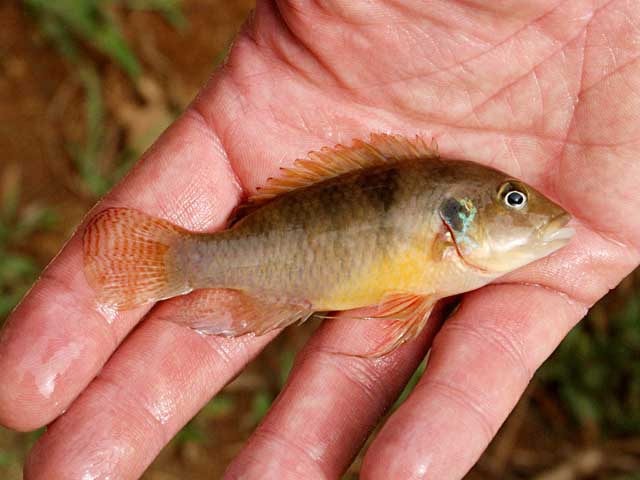| Cichlidae (Cichlids), subfamily: Pseudocrenilabrinae |
| 8.03 cm SL (male/unsexed) |
|
benthopelagic; freshwater, |
| Africa: known only from rivers and creeks in north-west Cameroon in the region of the Korup National Park (Ref. 81260). |
|
Dorsal spines (total): 15-16; Dorsal soft rays (total): 9-10; Anal spines: 3-3; Anal soft rays: 7-8. Diagnosis: dorsal fin membrane pale, without dense black band; vertical bars on flanks usually strongly marked; males with rows of dark maculae over entire caudal membrane, females with yellow-orange belly (Ref. 81260).
Description: body depth 34.0-38.8% SL; head length 34.1-38.0% SL; caudal peduncle deeper than long or slightly longer than deep; some dorsal and anal fin rays elongated (in males slightly more elongate than in females); caudal fin rounded in both sexes (Ref. 81260).
Coloration: body (dark) brown, paler ventrally (Ref. 52307, 81260). 4-6 well marked, vertical bars usually present on flanks, sometimes these are overlapped by 2 horizontal bands (particularly when stressed)(Ref. 52307, 81260). Dorsal fin and upper part of caudal with red margin (Ref. 81260). Females with chrome-colored/iridescent whitish to yellow region in soft dorsal, sometimes upper third of caudal also with such coloration; males with numerous rows of dark red maculae over entire caudal membrane (Ref. 52307, 81260). Juveniles with a "tilapia spot" that is retained in adults (Ref. 81260). Cheek and opercle with bluish/turquoise to light green iridescent flush (Ref. 52307, 81260). Lower lips white to light blue (Ref. 81260). Belly and flanks of ripe females with yellow to orange coloration (Ref. 52307, 81260). Males with well-developed dark margins on body scales; most
males with black markings on soft dorsal and anal fins (Ref. 52307). |
| Pair-bonding, ovophilic mouthbrooder (Ref. 52307, 81260) with delayed uptake (Ref. 81260). Spawns on open substrates (Ref. 81260). Both parents can brood offspring (Ref. 52307, 81260). |
|
Endangered (EN); Date assessed: 16 February 2009 (B1ab(iii)+2ab(iii)) Ref. (130435)
|
| harmless |
Source and more info: www.fishbase.org. For personal, classroom, and other internal use only. Not for publication.

